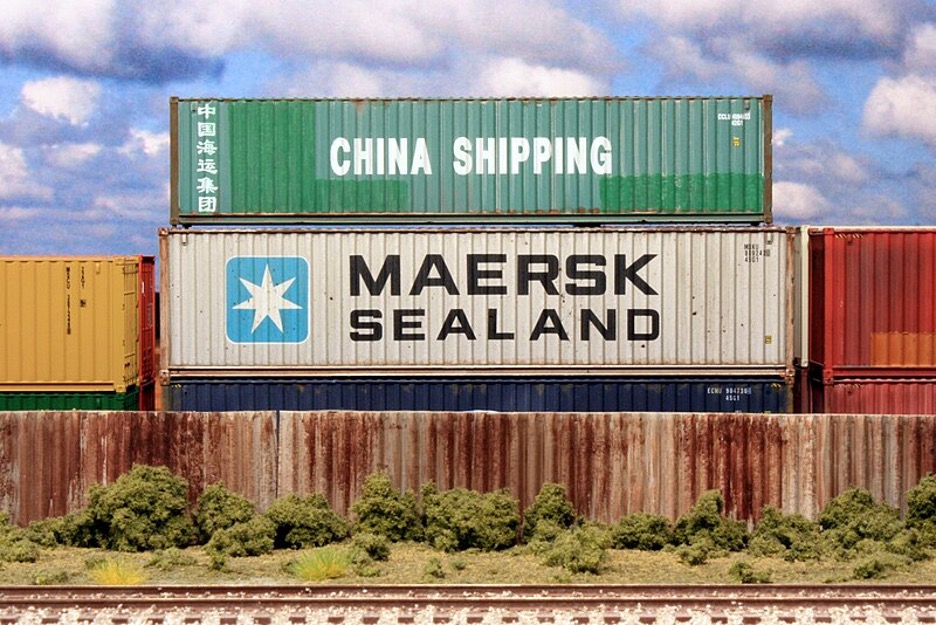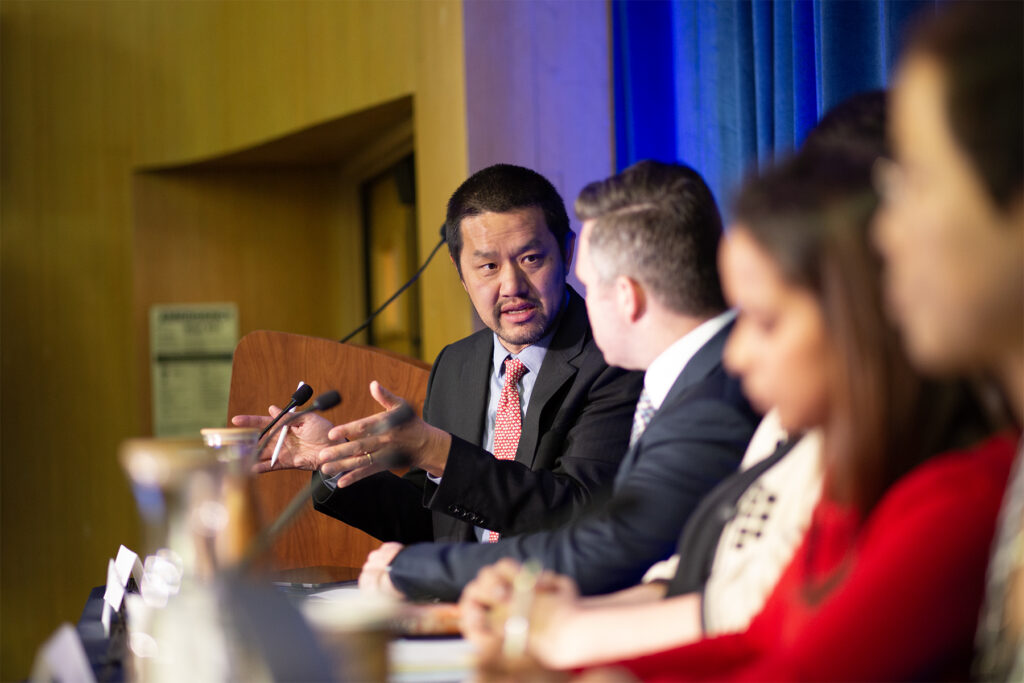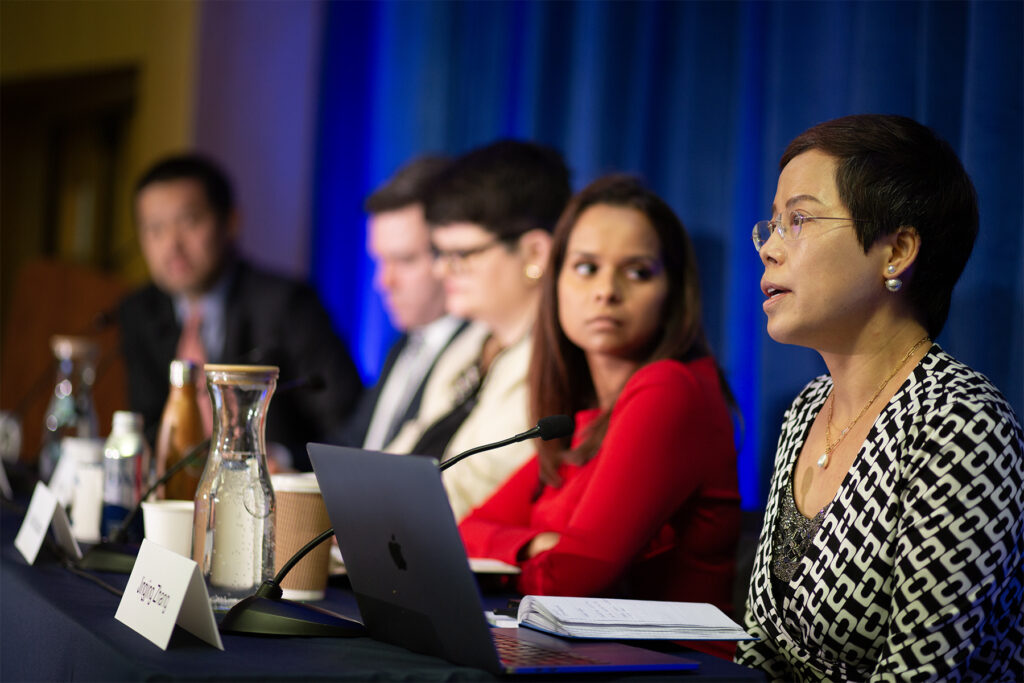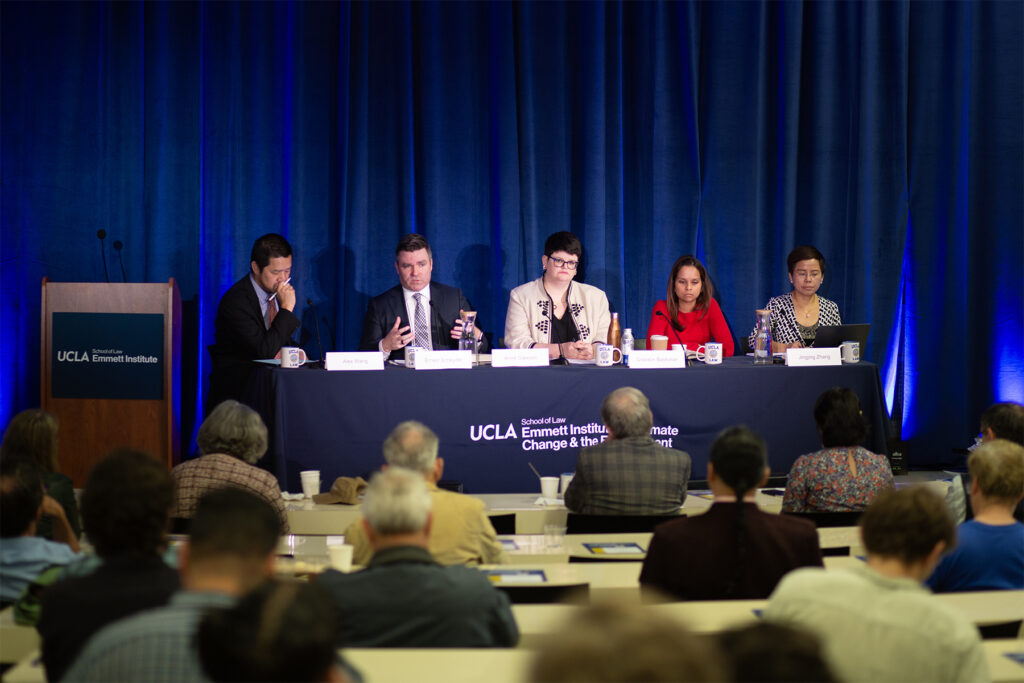Critical Insights on the Mineral Boom: Part III
On the rise of resource nationalism and building an equitable supply chain: Insights from the Emmett Institute’s “Powering the Future” symposium.

The topic of critical minerals and the energy transition is one of choices and priorities, at least according to author and journalist Ernest Scheyder, who spoke at the second panel in our recent “Powering the Future” symposium. This panel, Critical Minerals and Global Supply Chains, discussed some of the fundamental choices that governments, industry, and individuals have made and will make in the coming years to facilitate the energy transition. It also spoke to how we can––and must––navigate an uncertain future as we move from an extractive economy built on fossil fuels to a still-extractive economy built on lithium and other critical minerals.
It’s an issue that implicates questions of distributive and environmental justice, international protectionism, and economic uncertainty. As pointed out by Jingjing Zhang, Executive Director at the Center for Transnational Environmental Accountability, it also requires us to ask the question, “Critical to whom?” This question begs us to think deeply about whether the benefits and burdens associated with critical minerals extraction––and the energy transition more broadly––are distributed equitably across the global supply chain. To the extent that the answer is “No,” the panel described the steps that government and non-government actors have taken to address equity and human rights while also attempting to build out supply chains and secure future resource dominance in a changing geopolitical landscape. The panelists seemed to agree that these measures, such as direct regulations, tariffs, community consultations, and voluntary corporate accountability measures, have been imperfect solutions, both in concept and in execution.
All week, we have been sharing summaries, outcomes, and insights from our recent “Powering the Future” symposium. Make sure to check out Part I and Part II of this series. I’m pleased to wrap it up with this discussion on Panel Two, Critical Minerals and Global Supply Chains.
Panel Two: Critical Minerals and Global Supply Chains
The second panel, moderated by Prof. Alex Wang, focused largely (and deservedly) on how the United States’ tense relationship with China and other world powers has complicated the already-fraught landscape of critical minerals extraction. It also touched on themes of community engagement, permitting, and corporate responsibility.
Ernest Scheyder, Senior Correspondent at Reuters and author of The War Below: Lithium, Copper, and the Global Battle to Power our Lives, kicked off the discussion by foregrounding a central theme of the day: Choices. “Are there places that are too special to mine and what are the standards by which we allow mining?”
It’s a question of how we balance some of our most fundamental values, including equity, conservation, and human rights, which come into tension against the backdrop of an existential climate crisis. Evan George already highlighted the dilemma of the Tiehm’s buckwheat, a rare wildflower that sits atop a massive lithium reserve. But what about the decades-long fight over the Resolution Copper Mine at Oak Flat (Chi’chil Biłdagoteel), a site sacred to the Apache peoples? Here, the Ninth Circuit recently ruled against the plaintiff, Apache Stronghold, allowing a land swap negotiated between the mine operator and Congress to proceed as planned.
The decision is troubling from a historical context. The site is known as the birthplace of the Western Apache religion, yet the deal was brokered bilaterally during the Obama administration between the United States and Resolution Copper (owned by Rio Tinto, the world’s second-largest mining company, tacitly referred to later in the panel as the company that blew up a 50,000 year-old aboriginal ruin in Australia). Both the United States’ government and moneyed mining interests share far more culpability in the current climate crisis than the Apache peoples, so it’s particularly perverse that the fate of Chi’chil Biłdagoteel lies in their hands.
It also adds another dimension to how we talk about “choices.” The choices themselves are important, but so is the question of who gets to make them. At the heart of the discussion on equity and environmental justice is the need for autonomy and self-direction. As Secretary Christina Snider-Ashtari said in her keynote at the symposium, vulnerable communities asked to bear more of the burden must have “voice, agency, and meaningful compensation.” Secretary Snider-Ashtari illustrated just how necessary this is, reminding the room of the Native Americans murdered and enslaved here in California in the pursuit of gold. But this is only one of many tragedies that have resulted from a disconnect between decisionmakers and vulnerable communities, both here and abroad. While we are in the midst of an unprecedented climate crisis brought on by exploitative practices, that’s all the more reason to discontinue, not reinvigorate, these practices.

Next, Anne Clawson, Principal and Head of Government Affairs & Public Policy at Cascade Advisory, discussed the rise of “resource nationalism” across the global critical mineral supply chain. For resource-rich countries, particularly lower-income nations, this has meant demanding that mid- and downstream production facilities be sited in the country where the minerals are extracted. Clawson touted Indonesia as a country that has seen success in leveraging its critical mineral reserves to develop its own production and refinement capacity, including by requiring Indonesian companies to hold a majority stake in mines within the country. Other countries, however, have seen more mixed results, with the most fundamental risk being a failure to attract sufficient capital to cash in on the critical mineral boom.
China, on the other hand, has managed to build its own supply chain through investment in foreign natural resources and production both domestically and abroad, a point that panelists made several times throughout the day. As Jennifer Turner pointed out during the first panel, China gave itself a 20-year head start, despite holding only a tiny share of the world’s lithium reserves within its borders. China (or more accurately, a blend of private and state-affiliated companies based in China) has built out this supply chain through long-term overseas mineral investment, including in South America and Africa. This impressive buildout of capacity has allowed China to exercise its own brand of resource nationalism, restricting U.S. access to what panelist Gracelin Baskaran later termed the “the three Gs” (gallium, germanium, and graphite).
The rise of resource nationalism seems to have left many Western companies in an awkward position. A major theme of the day was the United States’ tardiness in investing in critical mineral extraction and processing to fuel the energy transition, and companies are now having a hard time dealing with that. Clawson noted that Ford was recently in the hot seat for its partnership with a Chinese company to invest in a $4.5 billion nickel plant in Indonesia. In late January, the chairs of two U.S. House Committees wrote to the Biden administration to demand the investigation of four Chinese companies involved in Ford’s planned Michigan battery plant, with one of those companies being Chinese battery giant CATL. Perhaps debacles like these are partly why the U.S. has invested in subsidies under the Inflation Reduction Act that earlier panelist Eduardo Bitran deemed protectionist in their own right, as described in our first recap post.
For companies, geopolitical tensions are further complicated by an uncertain demand for critical minerals well into the future. Clawson pointed out that the IEA recently estimated that global lithium demand could be between 13 and 42 times greater than it was in 2020. While this is a huge demand spike no matter how you look at it, this “lumpy” demand curve makes it tough for companies to determine how much they should be investing.

Jingjing Zhang spoke third. On a day sometimes characterized by geopolitical discussions that framed China, in turn, as a competitor, adversary, and (occasionally) model for the U.S., it was refreshing to me when Zhang reminded the audience that the country is not a monolith. In response to a commentator’s claim that China was willing to suffer environmental impacts for its dominance in critical mineral refinement: “Is that fact? That Chinese people are willing to drink water with heavy metals, eat rice with cadmium, and breathe air with PM2.5 particles? It’s not fact.” While this was a clear reminder to commentators to be thoughtful about how they discuss national or regional policies that have real impacts on peoples’ health and well-being, it also brings us back to our discussion on who gets to make the crucial choices that will help chart our path to a “clean energy future.” It’s doubtful that the people breathing contaminated air and consuming contaminated food and water are the ones making those policy choices. This is something to keep in mind as decisionmakers and the public continue to debate permit and environmental review reform that would purportedly help the U.S. compete with China. While ‘green red tape’ may not solve the problem of externalities, robust process is certainly a key tool to help affected communities find a seat at the table.
Zhang then quickly switched gears to something that maybe we should think about emulating elements of: China’s engagement with resource-rich communities in the Global South. Zhang spoke on her time working with communities in (among others) the DRC, Guinea, and Ghana, where community members described to her how representatives of Chinese corporate interests had engaged with communities in a culturally-competent and communicative manner. Even more critically, they listened to and complied with communities’ demands for fair compensation, equitable profit shares, environmental protections, and infrastructure like health clinics, roads, and bridges. It seems like a strategy with lots of upside and very little downside, and one would hope Western companies will make greater efforts to engage with local communities in the future, rather than simply working with national and regional governments.
Finally, Dr. Gracelin Baskaran, Research Director and Senior Fellow at the Center for Strategic and International Studies, shared her perspective on how Washington, D.C. is thinking about critical minerals. Dr. Baskaran made several cogent points on the United States’ scramble to build capacity (or perhaps just a reliable supply chain) in the mining sector, one that it had essentially abandoned when it closed the Bureau of Mines in 1996. Consequently, the U.S. has had to lean on allies like Australia, whose GDP is 15 percent mining (as compared to a meager 1 percent here in the states).
But soon, the discussion turned back to resource nationalism. In particular, Dr. Baskaran called attention to the “foreign entities of concern” guidance issued at the end of 2023, which precludes IRA dollars from going to companies with more than 25% ownership by China, Russia, Iran, or North Korea. The clear goal of this guidance is to help develop a supply chain outside of the control of Chinese companies and officials.
Dr. Baskaran alluded to the fact that this first batch of guidance includes some significant loopholes allowing companies to get around these protectionist measures. However, future iterations may further restrict access to IRA benefits by closing loopholes and further reducing the “foreign entity of concern’s” ownership stake necessary to be excluded from these benefits.

While I’m admittedly not an expert on EV supply chains, it seems that the Biden administration struck a clear balance here between U.S. aligned mining interests and EV manufacturers that rely heavily on critical minerals sourced from Chinese companies, favoring the mining interests. But I wonder how well this strategy will work. As far as I can tell, the House’s demands for President Biden to investigate the Michigan Ford battery plant still have not pressured the automaker into dropping its Chinese battery powerhouse partner. Maybe this guidance, or a future iteration, will do the trick. But in the meantime, I can’t help but wonder if Evan’s conclusion in our first symposium post is correct: The race is over, and we’re throwing the gauntlet for a fight we’ve already lost. Alternatively, maybe Victor Ban, Special Counsel at the Office of the U.S. Trade Representative, was correct in disagreeing with this assessment, stating that we are “we are running a different race and creating a different race.”
Once again, though, the discussion brought us back to choices. As Clawson mentioned earlier in the panel, the Trump and Biden approach to tariffs hasn’t seemed to work. China has now cut us off from the three Gs, which is particularly problematic as related to graphite. Dr. Baskaran noted that, while conventional vehicles don’t need graphite, 66 kg of a 210 kg electric vehicle is graphite. China processes 90 percent of the world’s graphite supply and the U.S. just 1 percent. This has put the country in a bind and presented the administration with a new set of choices: which global partners do we choose to work with?
The U.S. has answered this question, in part, by putting $150 million toward a graphite mine in a conflict zone in northern Mozambique. Residents of the region, one of the poorest in the world, have already faced exploitation, displacement, and violence over the country’s deposits of rubies and natural gas, both of which were discovered within the last 15 years. While one can hope that history does not repeat itself, it’s disheartening to see the U.S. turning a blind eye to this in its desperation for graphite. Dr. Baskaran also pointed to our renewed partnership with Saudi Arabia, a country with which the United States was recently very cold.
More and more, the race against (or parallel to, if you agree with Ban) China feels like a race to the bottom, repeating extractive practices we have seen in the past. On some level, these problems seem intractable, although there are glimmers of hope. Ruthie, in her post, pointed to enforceable community benefits agreements as a key vehicle for improving equity and environmental justice. Several panelists over the course of the day also made reference to investing in critical mineral recycling facilities (which often comes with its own set of environmental concerns). Long-term, I would also like to see policies designed to encourage us to live with less, like reducing our reliance on vehicles or encouraging us to repair, rather than periodically replace, the technology that powers our lives. Whichever direction we ultimately pursue, these choices will shape our lives for decades to come.






Reader Comments